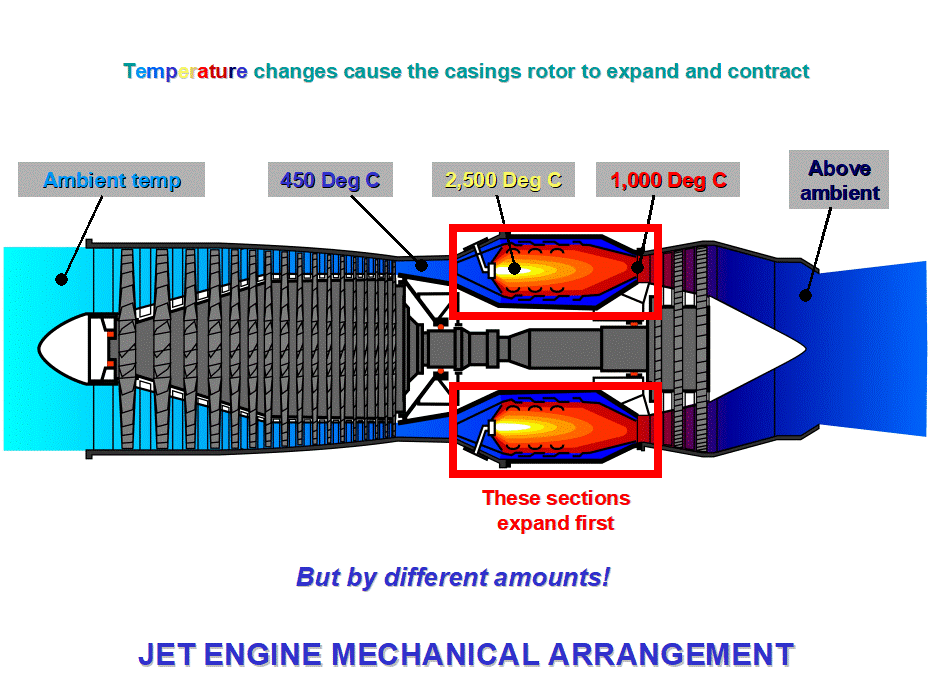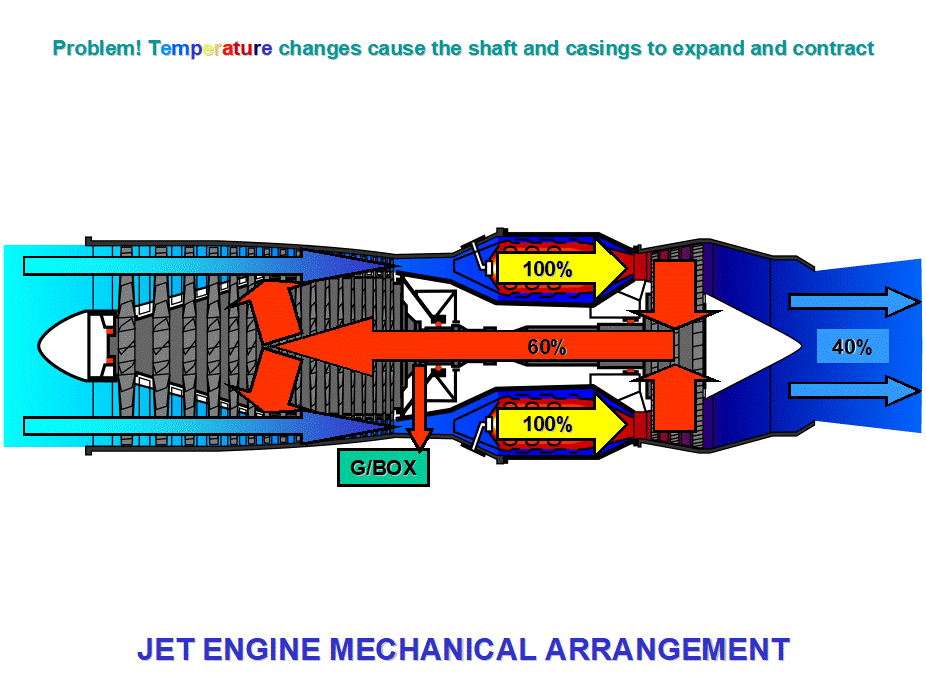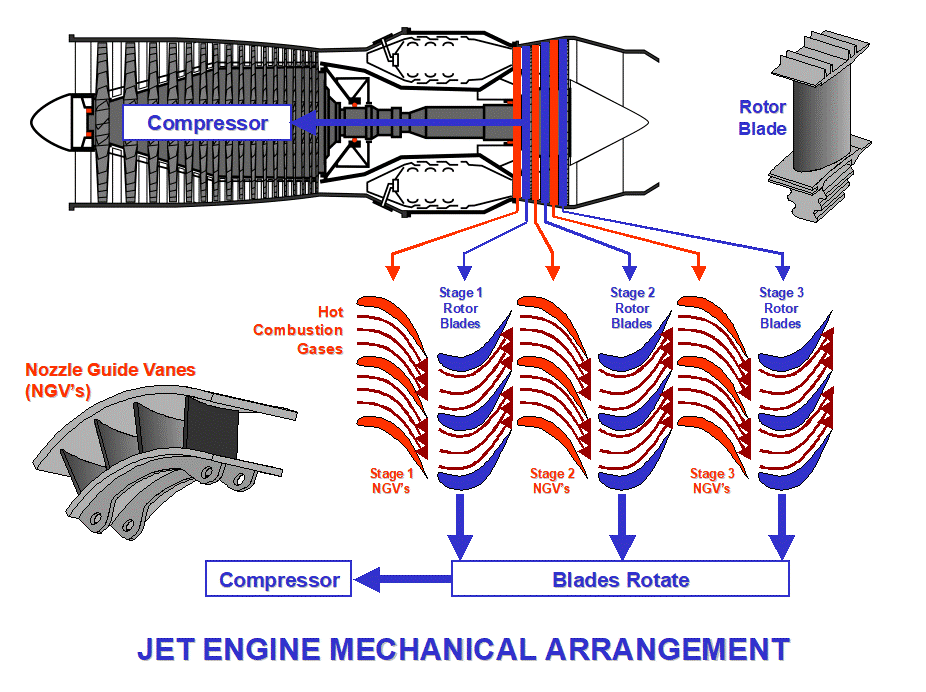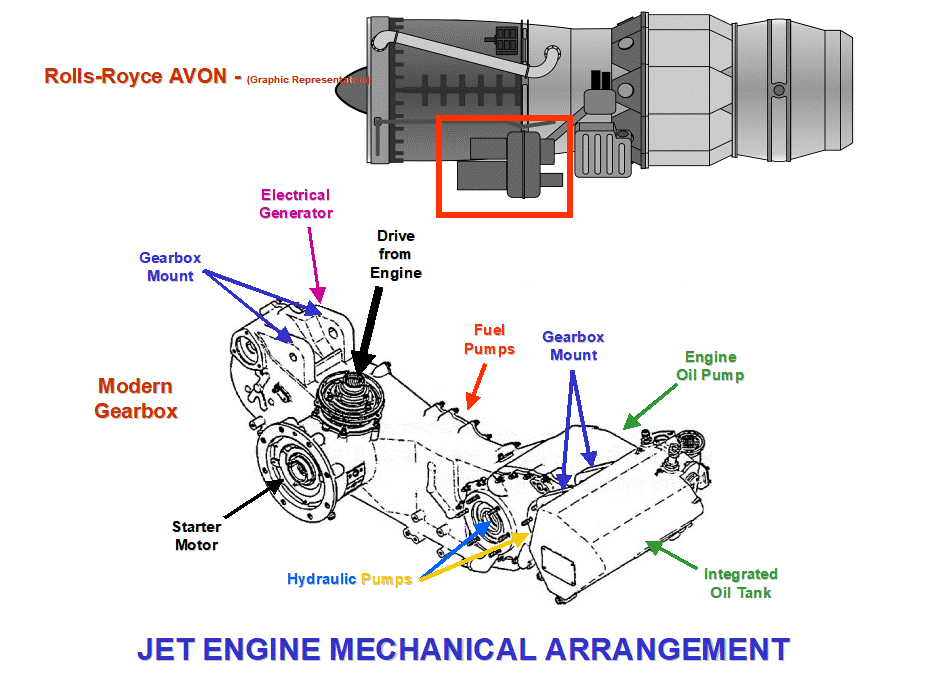Mechanical Arrangement – External Features
The jet engine used for the purposes of description in this section is the Rolls-Royce Avon. It is a relatively simple engine, single shaft with no by-pass, the latter making it a type known as a ‘Turbo-jet’. In this type of jet engine, all the air entering the engine passes through the combustion and turbine sections.
Other types of jet engine are described in Chapter 3 Types.
The illustration below shows a photograph of the engine and a graphical representation, with various external features highlighted, and described as follows: -
Anti-icing air tube
This tube carries hot air from the rear of the compressor, through a control valve, to the intake outer casing, front support vanes and front bullet. As these components are none rotating, ice can build up and restrict airflow into the engine reducing efficiency and thrust. The hot air heats up these components and keeps the front of the engine free of ice. The air is discharged back into the front of the compressor.
Compressor Handling Bleed Valve
This unit opens and allows air from the rear of the compressor to bleed overboard, when the engine is running at low rpm. This is to prevent engine surging in what is known as the ‘Off Design Condition’. The engine is designed to run smoothly and efficiently at just below cruise rpm to the take-off power settings (the ‘Design Condition’), below this power range the airflow through the compressor is not balanced or smooth, and the engine could surge.
The phenomenon of surge and compressor handling characteristics is a complicated and involved subject, and apart from the foregoing, is not covered in this syllabus.
Oil Tank
Used to hold the engine lubricating oil, and described in Chapter 4 Jet Engine Oil Systems.
Engine Front and Rear Mounts
Used to fix the engine into the aircraft, the rear mount on this engine is rigid to transmit the thrust to the airframe, the front mount is a flexible type that supports the engine weight and allows expansion and contraction due to temperature changes.
The mounts are used also to hold the engine into the work stand as shown below, with separate lifting points to lift the engine out of the stand and into the airframe.
External or Accessory Gearbox
Takes drive from the engine rotating shaft via and internal gearbox, to drive various system units mounted on the front and rear faces of the gearbox. See page 18 in this section.

Mechanical Arrangement – Internal Features
The illustration below shows the engine separated into the non rotating parts and the rotating assembly or shaft.
Non Rotating Parts – the Casings
The engine casing is made up of a series of small sections bolted together to form the complete casing. The casing is the structural frame work of the engine, providing the rigidity between the mount points, and providing the supports for the bearings in which the rotating assembly is located.
It also has to be strong enough to carry the weight of all the external fitments and accessories, such as the external gearbox, and strong enough to withstand the internal pressures (called ‘hoop-stress’) and temperatures.
In addition, the casing have to accommodate all these forces and stresses etc, without being too heavy. The power to weight ratio is very important, the heavier the engine, the less payload the aircraft can carry. Designers always strive to get he most power out of the lightest engine design.
Rotating Assembly – the Shaft
Located in the casings via the three bearing assemblies, the shaft is free to rotate at whatever rpm the combustion gases drive it at up to a maximum rpm to prevent rotor failure.
The compressor and turbine ‘drums’ are made up from a series of discs fixed together at the disc rims, by either bolting together or welded together or a combination of both depending on the engine design.
The discs are illustrated below; the blades fit into the discs around the rim; compressor blades generally use a ‘Dove-tail’ root and turbine blades generally use a ‘Fir-Tree’ root fixing.
Typical turbine blades are illustrated on page 15 and typical compressor blades are illustrated on page 17.

Mechanical Arrangement – Running Temperatures
As the air passes through the engine, its temperature is changed, first by compression, then by adding and burning fuel, then by passing the burnt gasses through the turbine section, then through the exhaust to atmosphere.
This temperature increase affects the engine by making the engine casings and rotor expand. The problem is when the engine is started, the casings will expand before the rotor does.
This would put huge stresses on the engine casings and rotor until the engine is ‘heat-soaked’ and running within the designed temperature range.
The bearings are selected to allow this differential expansion (and contraction on cool down) without causing undue stresses, these are described below.
Location Bearings
These are a ball type bearing where the ball runs in a track in both the inner race (part of the rotor) and the outer race (fixed in the casings).
As the name suggests, these bearings do not allow any lateral movement between the casings and the rotor, therefore these are in a fixed location at the bearing.
Roller Bearings
These bearings use rollers instead of ball bearing. The outer track (fixed in the casing) has a track to prevent the rollers from moving laterally.
The inner track (either fixed to the rotor or even simply a machined surface of the rotor shaft) will allow lateral movement of the casings without causing undue stress, the rollers simply move to a slightly different position on the inner track.
General
Both types of bearing will locate the rotor on the engine centre line, the axial location.
Both types of bearing have bearing ‘cages’, this is a phosphor bronze component which locates between the inner and outer bearing tracks, and ensures the balls or rollers are kept separate from each other, i.e. they are equally spaced around the diameter of the bearing assembly.
Lubrication of the bearings is extremely important. Running bearings generate their own heat and are subject to heat from the combustion process. The oil supply lubricates reducing friction and takes away heat from the bearings.
See section DJ04 Oil System for details.

Mechanical Arrangement – Combustion Design
Can Type
This design is the original design used in early jet engines with the exception of one type of WW2 era jet engine. Each combustion casing consists of an outer casing, an inner casing or flame tube, and a fuel spray nozzle (FSN). Two of the combustion casings would also have an igniter fitted.
This design had the advantage of being able to easily change the combustion casing assembly, sometimes without having to take the engine out of the aircraft.
Each outer casing and flame tube was connected to each other via ‘inter-connector tubes’, this was the even out the pressures, and help with the spread of flame upon start up.
Engines which featured this design were the early Whittle type up to the Dart engine.
Can-Annular Type
A development of the can type design where the flame tubes remain as individual cans, each with a FSN and inter-connectors, but they are surrounded by an annular casing. i.e. both the inner and outer encase all the flame tubes.
Engines which featured this design were the Conway, Olympus, Spey and Tay.
Annular Design
This design features both an annular flame tube within an annular outer casing and is the design of choice for modern engines. This design allows the fitting of more FSN’s (up to 20 or more depending on engine size), and gives an even pressure and temperature gasses to the turbine.
Engines featuring this design are the RB211 and virtually all modern jet engines.
General
The can type designs have a disadvantage in that when the turbine blades pass from one flame tube hot gas stream to the next, the blades cool down. This is a continuous effect, minute and frequent changes in temperature can lead to premature failure of the turbine blades; bad in itself but this could lead to catastrophic failure of the engine.
The big advantage of the totally annular design is that the gas temperature is constant around the turbine, thereby eliminating the temperature fluctuations.
Which ever design is used, the combustor cross section and therefore the airflow through it is essentially the same
Historical Note
The German WW2 fighter, Me262 Schwalbe (the first jet powered aircraft into service – although not the first to fly), was powered by two wing mounted Junkers Jumo 004B engines (2000lbs thrust) which featured axial flow compressors and an annular combustion chamber, quite advanced design for the era. Whittle designs of the same time were simpler centrifugal compressors and can type combustors.

Mechanical Arrangement – Combustion Operation
The illustration below shows a graphical representation of the cross section of the combustion section
Airflow from the Compressor
The airflow is split into two main flows: -
1. Approximately 82% of the air from the compressor passes around the outside of the inner flame tube. This air is then passes into the flame tube via a number of large and small ‘dilution’ holes (it is therefore known as ‘Dilution Air’) into the inside of the flame tube where it is heated by the combustion flame.
This airflow protects the flame tube from burning through and keeping it at an acceptable operating temperature in line with a satisfactory operational life.
2. Approximately 18% of the air passes immediately into the flame tube where it is split into another two main flows: -
A. Approximately half of the air passes around and through the end baffle plate (where the FSN is fitted) and swirls into the flame tube. It can be seen that this air flow produces a forward flow right at the point where the fuel is sprayed in.
B. Approximately half the airflow passes through swirl vanes situated around the FSN fuel jet. This swirl air hits the forward flow to produce what is known as a ‘Re-Circulating Vortex’.
The forward flow is necessary to prevent the airflow blowing the flame out the back of the engine, where no thrust could be produced i.e. the engine simply would not work.
This Re-Circulating Vortex is where the fuel is sprayed under high pressure (to provide atomization) into all this turbulent air, ensuring good air and fuel mixing and therefore efficient combustion.
Combustion
The flame temperature can be in excess of 2500ºC which is then reduced by the dilution air to around 1000ºC before entering the turbine.
An even flow of the dilution air is extremely important any slight blockage will unbalance the air around the flame and bias it towards the angle of the blockage; this could produce a disastrous burn through.
In addition, only a small proportion of oxygen is actually burnt with the fuel. In the RB211 series engines, although the combustion fuel/air ratio is 1:15. that is only at the point of combustion, in the re-circulating vortex. Total ratio is actually around 1:60, so there is still a lot of oxygen in the gas stream which can be useful for reheat systems.

Mechanical Arrangement – Power Distribution
If all the power developed in the combustor was available for thrust, all gas turbine engines would be either smaller or more powerful.
Unfortunately, power is required to drive the compressor to keep feeding air into the combustor to provide the thrust.
The turbine extracts approximately 60% of the power from the gas stream to drive the compressor and the accessories via the external gearbox.
What is left, approximately 40%, is used to produce the engine thrust, to drive the aircraft forward.

Mechanical Arrangement – Turbine Operation
Nozzle Guide Vanes (NGV’s)
When the hot combustion gasses leave the flame tube, they pass through the 1st stage NGV’s. the NGV’s affect the gas stream in two ways, one is to accelerate the gasses, the other is to direct the gas stream onto the turbine blades at the optimum angle.
Both the angle and the velocity of the gas stream are very important to drive the turbine at the fastest speed possible from the energy available.
Turbine Blades
The turbine blades are driven by the gas stream passing through them, just the same as the wind drives a windmill.
The outer platform incorporates air seals which prevent gas stream seepage over the blade. Any gas stream which doesn’t pass between the blade aerofoil section is lost in terms of driving the turbine.
Some are designed without the outer platform, and use a turbine case cooling system to control the tip gaps, preventing gas losses over the blade.
There are two types of turbine blade aerofoil section, Impact and Reaction.
Impact Turbine Blades
These are driven simply by the weight of the gas stream hitting it, much the same as a water wheel is driven by the weight of the water flowing over it.
Reaction Turbine Blades
In this type of turbine blade, the gap between adjacent turbine blades is smaller at the trailing edge compared to the leading edge, thus forming a convergent duct.
The gas stream properties are altered by the shape of the duct it passes through. In a convergent duct pressure and temperature are reduced, but velocity is increased.
This increase in velocity of the gas stream leaving the turbine blade, has ‘An opposite and equal effect’, i.e. the gas stream increases rotational speed of the turbine by jet reaction.
Modern Turbine blades
Modern designed turbine blades combine both types, impact and reaction near the root, and reaction towards the tip.
Turbine Stages
A turbine stage consists of a NGV then the turbine blades immediately behind it.
The foregoing description of the gas stream passing through the NGV’s and the turbine blades, is repeated for each stage of the turbine, albeit there is slightly less energy to deal with for each turbine stage passed.
The overall path the gas stream takes through the turbine is almost straight.

Mechanical Arrangement – Compressor Operation
Compressor Blades
Compressor blades are aerofoil section which produce lift just the same as a aircraft wing or propeller blade. As the blades rotate they force air rewards into the compressor stators.
Compressor Stator Vanes
Stator vanes aye attached in clusters, or a complete ring to the engine casings, and are similar to the compressor blades in aerofoil section.
Compressor Stage
Each stage of the compressor is made up from a rotor blade in front of the stator vanes.
It is the blades that push the air rewards, and the stators which compress it. Each stage produces a small pressure rise which factored for the number of stages in a compressor, would produce a overall pressure rise, known as the ‘Pressure Ratio’; this value will be included in the engine specifications.
Pressure ratios around 26:1 (meaning compressor delivery pressure is 26 times ambient) are common.
Air Path
Due to the operating nature of the compressor, the airflow does not travel straight through the compressor.
The rotor blades push the air round the engine slightly, whereas the stator vanes straighten it out, the actual air path is shown below.

Mechanical Arrangement – Accessory Gearbox
External gearboxes take drive from the engine rotor shaft to drive various system accessories.
On modern systems, the starter motor drive is placed inline or very near the input drive shaft. The reason for this is, when the engine is started, the starter motor drives the gearbox which then drives through the input shaft to the engine rotor. Placing the starter in this position removes a lot of stress on the gearbox gears.
Access to the internal gears is usually gained by splitting a bolted flange all round the gearbox and separating the gearbox casing. Newer designs allow the individual gears to be removed whilst the gearbox and engine is installed, access being gained by removing the accessory and then a cover plate.
The engine lubricating system oil tank is also mounted, or an integral part of, the gearbox on a lot of engines, removing the need for a separate oil tank.
The engine fuel pump and oil pump operation is covered in sections DJ05 Fuel System and DJ04 Oil System respectively.

Source: https://www.2473atc.org.uk/trainingMaterial/Master/MASTER%20jet%20engine%20propulsion/CHAPTER%201%20NOTES.doc
Web site to visit: https://www.2473atc.org.uk
Author of the text: indicated on the source document of the above text
If you are the author of the text above and you not agree to share your knowledge for teaching, research, scholarship (for fair use as indicated in the United States copyrigh low) please send us an e-mail and we will remove your text quickly. Fair use is a limitation and exception to the exclusive right granted by copyright law to the author of a creative work. In United States copyright law, fair use is a doctrine that permits limited use of copyrighted material without acquiring permission from the rights holders. Examples of fair use include commentary, search engines, criticism, news reporting, research, teaching, library archiving and scholarship. It provides for the legal, unlicensed citation or incorporation of copyrighted material in another author's work under a four-factor balancing test. (source: http://en.wikipedia.org/wiki/Fair_use)
The information of medicine and health contained in the site are of a general nature and purpose which is purely informative and for this reason may not replace in any case, the council of a doctor or a qualified entity legally to the profession.
The texts are the property of their respective authors and we thank them for giving us the opportunity to share for free to students, teachers and users of the Web their texts will used only for illustrative educational and scientific purposes only.
All the information in our site are given for nonprofit educational purposes